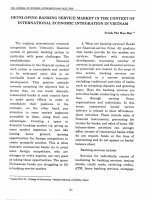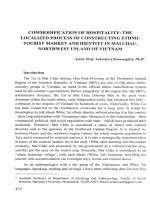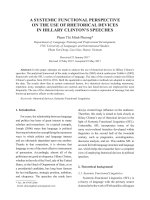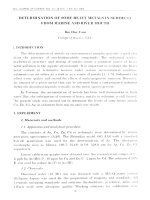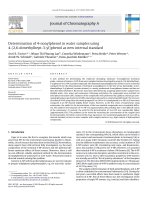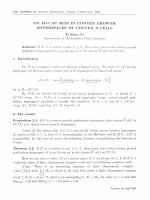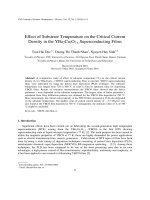DSpace at VNU: Roles of nano-sized Au in the reduction of NOx by propene over Au TiO2: An in situ DRIFTS study
Bạn đang xem bản rút gọn của tài liệu. Xem và tải ngay bản đầy đủ của tài liệu tại đây (1.35 MB, 8 trang )
Applied Catalysis B: Environmental 96 (2010) 299–306
Contents lists available at ScienceDirect
Applied Catalysis B: Environmental
journal homepage: www.elsevier.com/locate/apcatb
Roles of nano-sized Au in the reduction of NOx by propene
over Au/TiO2 : An in situ DRIFTS study
Long Q. Nguyen a,b,∗ , Chris Salim a , Hirofumi Hinode a
a
b
Department of International Development Engineering, Tokyo Institute of Technology, 2-12-1 Ookayama, Meguro-Ku, Tokyo 152-8550, Japan
Faculty of Chemical Engineering, Ho Chi Minh City University of Technology, 268 Ly Thuong Kiet Street, District 10, Ho Chi Minh City, Viet Nam
a r t i c l e
i n f o
Article history:
Received 21 August 2009
Received in revised form 11 February 2010
Accepted 12 February 2010
Available online 19 February 2010
Keywords:
In situ DRIFTS
Nano-sized Au
Au/TiO2
Mechanism
SCR
a b s t r a c t
A mechanistic study of the selective catalytic reduction (SCR) of NOx by C3 H6 has been investigated over
nano-sized Au/TiO2 catalyst using in situ diffuse reflectance Fourier transform infrared spectroscopy
(DRIFTS). The formation and consumption of adsorbed species on the catalyst surface have been intensively studied during co-adsorption of reactants and reaction condition. The presence of nano-sized
Au particles played an important role in the formation of oxygenated hydrocarbons, especially acetate
species. Importantly, Au active sites were crucial to the formation of isocyanate intermediate compounds
and contributed to the conversion of these intermediates to N2 . The reaction mechanism of SCR over
Au/TiO2 has been discussed on the basis of DRIFTS results.
© 2010 Elsevier B.V. All rights reserved.
1. Introduction
In the concerns of energy crisis and global warming, lean-burn
engines, which work at high air/fuel ratio, are essentially promising for automobile industry because of their high fuel efficiency,
and low CO2 emission. However, these engines produce exhaust
containing a large excess of oxygen making the commercial threeway catalyst (TWC) impossible for NOx reduction [1,2]. Thus, the
reduction of NOx emission from lean-burn engine exhaust remains
a challenge to both academic research and the automobile industry.
Researchers have reported the possibility of applying nanosized gold catalysts for the selective catalytic reduction of NOx by
hydrocarbons (HC-SCR). For example, Ueda et al. [3–5] reported
that supported gold catalysts are active for reduction of NO with
hydrocarbons (propene, propane, ethane, and ethene) in the presence of moisture and excess oxygen. Among different metal oxide
supports, Al2 O3 exhibited the highest conversion of NO to N2 [3].
Since then, other research groups focused on the development of
Au/Al2 O3 catalysts for HC-SCR [6–9]. However, the disadvantage
of Au/Al2 O3 is that it is effective at quite high reaction tempera-
∗ Corresponding author at: Department of International Development Engineering, Tokyo Institute of Technology, 2-12-1 Ookayama, Meguro-Ku, Tokyo 152-8550,
Japan. Tel.: +81 84 165 4649 236.
E-mail addresses: , ,
(L.Q. Nguyen).
0926-3373/$ – see front matter © 2010 Elsevier B.V. All rights reserved.
doi:10.1016/j.apcatb.2010.02.020
tures which are not favorable for treatment of diesel exhaust [3,6,7].
Moreover, the drawback of using support Al2 O3 is the deactivation
caused by SO2 originating from fuel [10,11]. On the other hand,
TiO2 is a promising alternative support since the sulfation of TiO2
in a SO2 atmosphere is difficult [12], and this sulfur-resistant support has been widely used for the NOx selective catalytic reduction
by NH3 (V2 O5 /TiO2 ) [13]. However, there is not much attention
given to the HC-SCR activity of the TiO2 supported gold catalysts.
Mechanisms of HC-SCR by Al2 O3 supported nano-sized Au catalysts were proposed in a few publications [3,8]. Ueda’s group
suggested that the formation of NO2 by the oxidation of NO with O2
may be the first and slowest step followed by the reaction of NO2
with C3 H6 . In situ diffuse reflectance Fourier transform infrared
spectroscopy (DRIFTS) was used in research of Bamwenda et al. over
Au/␥-Al2 O3 catalyst [8]. The oxidation of NO to NO2 is a prerequisite
step followed by coupling of the NO2 or its adspecies (NOx − ) with
activated C3 H6 on active site on Al2 O3 to form Cn Hm Nx Oy species,
such as –NCO or –CN, which are responsible for the propagation
step. Their subsequent internal rearrangement and decomposition
lead to the formation of N2 and other products. However, there is no
report to date about mechanism of SCR by propene over Au/TiO2
catalyst, which performed better catalytic activity than Au/Al2 O3
at low temperatures [14,15]. The present study concentrates on
the investigation of roles of nano Au particles in the SCR reaction,
especially in the formation and consumption of adsorbed species
on Au/TiO2 by using in situ DRIFTS. A proposed reaction mechanism
based on DRIFTS results is also discussed.
300
L.Q. Nguyen et al. / Applied Catalysis B: Environmental 96 (2010) 299–306
In the DRIFTS measurement, Au/TiO2 containing 1 wt.% Au
was mainly used. The sample powder (approximately 20 mg) was
placed in a diffuse reflectance cell (DR-600Bi, Jasco corp.) which
was coupled with a temperature controller. The cell was fitted by a
KBr window at the top. Infrared spectra were recorded with a JASCO
FT/IR-6100FV using a MCT-M detector cooled by liquid N2 . A total
of 64 scans were accumulated at a resolution of 4 cm−1 in different
temperatures ranging from 150 to 400 ◦ C. Prior to each experiment, the sample was pretreated in situ at 500 ◦ C in helium stream
(100 ml/min) for 30 min, followed by cooling to the desired temperature and then stabilizing for 30–60 min. The spectrum at this stage
was collected and used as the background for other spectra at the
corresponding temperature. Various gas mixtures were fed in situ
to the catalyst at the same flow-rate of 100 ml/min. The concentrations (if presented) of NO, NO2 , C3 H6 , and O2 in the gas mixture were
1500 ppm, 1500 ppm, 1500 ppm, and 10%, respectively, with He as a
balance. The adsorption of each reactant has been carefully carried
out at different temperatures to understand the adsorbed-species
formation. The surface adsorbed species during the C3 H6 -SCR of NO
over Au/TiO2 catalyst at different temperatures were clarified by
both simultaneously feeding and consecutive feeding of the reactants.
Fig. 1. DRIFTS spectra of adsorbed species over Au/TiO2 after exposing in the flow of
NO + O2 for 40 min at different temperatures. Conditions: NO = 1500 ppm, O2 = 10%.
3. Results and discussion
2. Experimental
3.1. Formation of adsorbed species during co-adsorption of
reactants
The Au/TiO2 catalysts were prepared from JRC-TiO-7 (a reference catalyst of the Catalysis Society of Japan, 100% anatase)
and HAuCl4 ·4H2 O (99.9%, Wako Co.) by metal–sol method using
polyvinyl alcohol (PVA) as describe elsewhere [14]. In brief, a
freshly prepared solution of NaBH4 was slowly added dropwise into
the solution containing HAuCl4 and PVA (weight ratio PVA/Au = 1).
The JRC-TiO-7 was added after the pH was adjusted to 6.0 using
ammonia solution. After washed, and dried at 100 ◦ C overnight, the
catalysts were calcined at 550 ◦ C for 4 h. The average Au particle size
on TiO2 support was about 5.0 nm with 60% particles in the size
of 3–5 nm as determined from transmission electron microscopy
(TEM) using JEM-2010F (JEOL Ltd.) [14]. For comparison, the fresh
JRC-TiO-7 support was calcined at 550 ◦ C for 4 h and referred as
TiO2 . The BET surface areas of the TiO2 and Au/TiO2 , which were
measured by Autosorb-1 (Quantachrome Instrument Corp.), were
115 and 102 m2 /g, respectively [15].
The DRIFTS spectra obtained after the Au/TiO2 catalyst was
exposed to NO/O2 for 40 min at various temperatures are reported
in Fig. 1, in which assignment of the absorbance bands was listed
in Table 1. Bands of bridging nitrate (1605, and 1245 cm−1 ), bidentate nitrate (1585, and 1285 cm−1 ), monodentate nitrate (at 1517,
and 1285 cm−1 ) were observed. Monodentate species were only
detected at 150 ◦ C while bridging and bidentate species were
observed at all temperatures. When the exposing temperature was
increased, the intensities of nitrate bands were decreased, especially from 300 ◦ C. Comparison of DRIFTS spectra between TiO2 and
Au/TiO2 after exposing to NO/O2 for 40 min is shown in Fig. 2. The
results at 200 and 300 ◦ C were reported. We obtained almost similar
spectra for both samples at each temperature. Thus, the adsorbed
species during NO/O2 /He exposure were formed by and located on
the TiO2 support. The Au particle did not contribute to the formation
of nitrate adsorbed species.
Table 1
Wavenumbers and assignment of adsorption bands in DRIFTS spectra.
Wavenumber (cm−1 ) (this work)
1605
1245
1580–1585
1285
1517
1285
2956
2875
1550
1381
1360
2986, 2936
1550
1440
2978, 2936
1675
1718
2291–2262
2175–2202
1645
Surface species
−
Bridging NO3 (M–O)2 NO
Interpretation
s (ONO)
as (ONO)
Bidentate NO3 − (M–O2 NO)
s (ONO)
as (ONO)
Monodentate NO3 − (M–O–NO2 )
s (ONO)
as (ONO)
H–COO−
as (COO) + ı(CH)
s (CH)
CH3 –COO−
CH3 –CO–CH3
CH3 –CHO
–CN
–NCO
–OH of H2 O
as (COO)
ı(CH)
s (COO)
(CH)
as (COO)
s (COO)
(CH)
(C O)
(C O)
(Ti–C N)
as (Ti–N C O)
ı(OH)
Wavenumber (cm−1 ) (literature)
Reference
1607–1611
1252–1258
1582–1589
1296–1298
1510–1513
1296–1298
2957
2873
1554
1381
1360
2984–2987, 2936
1540
1440
2973, 2931
1702
1718
2317–2234
2174–2209
1635–1650
[16]
[16,17]
[16]
[18]
[18–21]
[22]
[23]
[22,24,25]
[25,26]
[22]
L.Q. Nguyen et al. / Applied Catalysis B: Environmental 96 (2010) 299–306
301
Fig. 2. Comparison spectra of surface adsorbed species between Au/TiO2 and TiO2
after exposing to the NO + O2 mixture for 40 min at 200 and 300 ◦ C. Conditions:
NO = 1500 ppm, O2 = 10%.
Fig. 4. DRIFTS spectra of adsorbed species over Au/TiO2 after exposing in a flow
of C3 H6 or C3 H6 + O2 for 40 min at 200 ◦ C in comparison with the TiO2 . Conditions:
C3 H6 = 1500 ppm, O2 = 0 or 10%.
The DRIFTS spectra of surface species recorded after 40 min
in the flow of C3 H6 /O2 at different temperatures over Au/TiO2
are shown in Fig. 3, in which assignment of the absorbance
bands was listed in Table 1. The observable oxygenated hydrocarbons were formate (2956, 2875, 1550, and 1381 cm−1 ), acetate
(2986, 2936, 1550, and 1440 cm−1 ), and acetone (2986, 2936,
and 1675 cm−1 ). The presence of acetone on the catalyst surface
was only detected until 250 ◦ C. The intensity of formate band at
2875 cm−1 was increased when the temperature rose upto 250 ◦ C,
then it decreased. Thus the amount of adsorbed formate species was
reduced at high temperature after reaching the maximum at 250 ◦ C.
On the other hand, intensity of acetate band at 1440 cm−1 was
increased as elevating temperature and remained strong at very
high temperatures (300–400 ◦ C). Band at 1645 cm−1 was assignable
to adsorbed H2 O. The appearance of this band indicated that the
total oxidation of C3 H6 by O2 was occurred.
The role of nano Au particles in the formation of oxygenated
hydrocarbons may be deduced from the difference in the spectra
shown in Fig. 4. The spectra (a) and (c) were recorded at 200 ◦ C
over TiO2 and Au/TiO2 after 40 min in a flow of C3 H6 /O2 (a and c).
The spectrum (b) was obtained over Au/TiO2 after exposing in an
O2 -free stream. During C3 H6 /O2 /He exposure, only weak band of
acetone (1675 cm−1 ) was obtained on the support TiO2 comparing
to the much stronger bands of acetate (1550, 1444 cm−1 ), formate
Fig. 3. DRIFTS spectra of adsorbed species over Au/TiO2 after exposing in flow of C3 H6 + O2 for 40 min at different temperatures. Conditions: C3 H6 = 1500 ppm, O2 = 10%.
302
L.Q. Nguyen et al. / Applied Catalysis B: Environmental 96 (2010) 299–306
Fig. 5. DRIFTS spectra of adsorbed species over Au/TiO2 after 40 min in
flows of NO + C3 H6 + O2 at different temperatures. Conditions: NO = 1500 ppm,
C3 H6 = 1500 ppm, O2 = 10%.
(1550, 1381 cm−1 ), and acetone (1675 cm−1 ), on the Au/TiO2 . Thus,
nano Au particles are essential for the partial oxidation of C3 H6
forming oxygenated hydrocarbons. From spectrum (b) of Fig. 4, it
is noted that the adsorbed oxygenated species (acetate, formate
and acetone) can be formed on Au/TiO2 without O2 existence. In
this case, these species might be formed by the reaction between
C3 H6 and surface (-OH) groups of the support. However, the presence of oxygen led to the more oxygenated hydrocarbons generated
on the catalyst’s surface as reflected from the stronger intensities
obtained in spectrum (b) in comparison with spectrum (c). The lost
of TiO2 surface (–OH) groups was observed because of the negative bands around 3715 cm−1 (data not shown). Thus, the adsorbed
oxygenate species, which formed by the catalysis of Au particles,
were probably located on the support sites near Au particles.
3.2. Formation of adsorbed species during SCR reaction
The collection of DRIFTS spectra after the Au/TiO2 catalyst was
exposed to the reaction mixture (NO/C3 H6 /O2 /He) for 40 min at
various temperatures from 150 to 400 ◦ C is shown in Fig. 5.
In the spectral range 1900–900 cm−1 , adsorbed oxygenated
hydrocarbons were acetaldehyde (1718 cm−1 ), acetate (1550,
1440 cm−1 ) and formate (1550, 1381, 1360 cm−1 ). The band
of acetaldehyde was observed in the temperature range of
150–250 ◦ C. Acetone band at 1675 cm−1 , which was observed in
the co-adsorption C3 H6 /O2 (Fig. 3), was not obviously detected in
the reaction condition. Additionally, intensities of formate bands
(1381, 1360 cm−1 ) were remarkably stronger than those obtained
during co-adsorption C3 H6 /O2 (Fig. 3). Thus, the presence of NO
in the gas stream contributes to the increases in amount of oxygenated hydrocarbons, especially acetaldehyde and formate, at low
temperatures. However, the spectra in this frequency range of Fig. 5
at higher temperatures (300–400 ◦ C) were almost similar to those
obtained in the co-adsorption C3 H6 /O2 (Fig. 3) at the respective
temperatures. Taking the results of co-adsorption NO/O2 (Fig. 1)
into account, it is seen that bidentate nitrate (1580, 1285 cm−1 ) was
the predominant nitrate species presented on the catalyst surface.
Fig. 6. DRIFTS spectra of adsorbed species after 40 min in streams NO + C3 H6 + O2
over TiO2 and Au/TiO2 at indicated temperatures. Conditions: NO = 1500 ppm,
C3 H6 = 1500 ppm, O2 = 10%.
Bridging (1605, 1245 cm−1 ) and monodentate (1517, 1285 cm−1 )
species were only observed at 150 ◦ C. The formation of bridging
nitrate became difficult in the presence of C3 H6 probably due to
the competitive adsorption on the surface active sites.
Importantly, several bands were observed only in the reaction conditions in the wavenumber range of 2300–2100 cm−1 .
These bands are attributed to cyanide (–CN) (2291–2262 cm−1 ),
and isocyanate (–NCO) (2192–2175 cm−1 ) compounds. They have
been considered as important intermediates of the SCR of NO
by hydrocarbons [1]. These bands were observed obviously in
150–300 ◦ C. However, the spectra obtained at different reaction
times indicated that the intensity of (–NCO) band, not (–CN), was
gradually increased when the reaction time was increased. The
intensity of (–NCO) bands were reduced when the temperature was
increased. The (–NCO) bands were not detected at very high temperatures (350, 400 ◦ C). Over Au/Al2 O3 catalyst, however, bands of
these species, especially (–NCO), were strongly detected at higher
temperatures (between 350 and 450 ◦ C) and they disappeared at
temperature above 500 ◦ C [8]. Consistently, high catalytic activity
of Au/Al2 O3 was obtained at relatively higher temperatures than
that of Au/TiO2 [3,5–7].
The differences of surface species formed during SCR reaction on
the TiO2 and Au/TiO2 are shown in Fig. 6. At 200 ◦ C, the observed
bands in the region 1900–900 cm−1 were similar over both samples, except the intensity of band of adsorbed H2 O (1645 cm−1 )
which was much higher in the case of Au/TiO2 . On the TiO2 support,
unlike the results in co-adsorption C3 H6 /O2 (Fig. 4), adsorbed oxygenated hydrocarbons such as acetate, formate, acetaldehyde can
be strongly detected during the C3 H6 /O2 /NO exposure. Thus, these
species were formed with the presence of NO in the gas stream
by active sites on TiO2 . However, at this temperature a significant difference between TiO2 and Au/TiO2 was the (–NCO) band
at 2180 cm−1 . This band was only strongly observed on Au/TiO2 .
Therefore, nano-sized Au particles were crucial to the formation of
these key intermediates.
Comparative results at 300 ◦ C indicated that band of acetate
(1440 cm−1 ) on Au/TiO2 was significantly stronger than that on
TiO2 as seen from Fig. 6. Therefore, the presence of nano-sized Au
particles accelerates the formation of surface acetate species. More-
L.Q. Nguyen et al. / Applied Catalysis B: Environmental 96 (2010) 299–306
303
Fig. 7. Dynamic change of DRIFTS spectra of adsorbed species in streams NO + C3 H6 + O2 over TiO2 , 0.1%Au/TiO2 and 1%Au/TiO2 at 300 ◦ C. Conditions: NO = 1500 ppm,
C3 H6 = 1500 ppm, O2 = 10%.
over, although the intensities of (–NCO) bands were almost similar
in both samples at 300 ◦ C but the origins may be different. The low
intensity of (–NCO) band in Au/TiO2 may be originated by the fast
conversion of these intermediates to N2 . Contrarily, hardly forming
(–NCO) on TiO2 without the presence of nano Au particles led to the
low intensity of the band.
The dynamic changes in DRIFTS spectra of surface adsorbed
species during the reaction stream NO/C3 H6 /O2 at 300 ◦ C over
TiO2 and Au/TiO2 (1 or 0.1 wt.% Au) were shown in Fig. 7. The
spectra were recorded after 5, 20, and 40 min. It is seen that
after 5 min (–NCO) species (2180 cm−1 ) were obviously observed
on 1%Au/TiO2 and 0.1%Au/TiO2 . The intensity of the band was
almost similar in both samples. However, while intensity of (–NCO)
band on 1%Au/TiO2 was nearly unchanged until 40 min, that
on 0.1%Au/TiO2 kept increasing. It suggests that the accumulation of (–NCO) compounds was observed on 0.1%Au sample,
but not on 1%Au sample. Therefore, nano-sized Au particles contributed to the conversion of (–NCO) intermediates possibly to
N2 .
3.3. Consumption of adsorbed species
The consumption of adsorbed oxygenated hydrocarbons (acetone, acetate and formate) is shown in Figs. 8 and 9. The Au/TiO2
sample was first exposed to C3 H6 /O2 stream for 40 min then
purged by He for 20 min, and finally flowed NO/O2 . In the region
(2300–1200 cm−1 ), the reduction of acetone band at 1675 cm−1
was obviously observed in the results at 200 and 250 ◦ C of Fig. 8.
Fig. 8. DRIFTS spectra in the range (2300–1200 cm−1 ) recorded over Au/TiO2 after flowing of C3 H6 + O2 for 40 min (a) followed by purging He for 20 min (b), then flowing of
NO + O2 (c and d) at the indicated temperatures and times.
304
L.Q. Nguyen et al. / Applied Catalysis B: Environmental 96 (2010) 299–306
Fig. 9. DRIFTS spectra in the C–H stretching region and (–NCO) bands recorded over Au/TiO2 after flowing of C3 H6 + O2 for 40 min (a) followed by purging He for 20 min (b),
then flowing of NO + O2 (c and d) at the indicated temperatures and times.
Simultaneously, band of acetaldehyde at 1718 cm−1 was appeared
which may imply that the conversion of acetone to acetaldehyde was occurred at those temperatures. Some research groups
proposed the important role of aldehydes such as acetaldehyde
and formaldehyde in the formation of (–NCO) [27,28]. However,
the observation over Au/TiO2 did not follow this proposal since
(–NCO) band (2180 cm−1 ) was not detected even though the
acetaldehyde band (1718 cm−1 ) was strongly recorded. Furthermore, although acetate and formate bands (1550, 1440, 1381 cm−1 )
were almost unchanged at those temperature, these bands were
significantly decreased at 300 ◦ C. It indicated that the adsorbed formate and acetate were rapidly consumed in the flow of NO/O2 at
300 ◦ C.
The changes of adsorption bands in the (C–H) stretching region
(3000–2800 cm−1 ) at 200, 250, and 300 ◦ C are reported in Fig. 9.
It should be noted that, the band at 2936 cm−1 can attribute to
both acetone and acetate. At 200–250 ◦ C, the decrease of this
band together with band at 1675 cm−1 (acetone, Fig. 8) and the
appearance of acetaldehyde band at 1718 cm−1 (Fig. 8) suggested
that the 2936 cm−1 band is assigned to acetone at these temper-
Fig. 10. DRIFTS spectra recorded over Au/TiO2 after flowing of NO + O2 for 40 min (a) followed by purging He for 20 min (b), then flowing of C3 H6 + O2 (c and d) at the indicated
temperatures and times.
L.Q. Nguyen et al. / Applied Catalysis B: Environmental 96 (2010) 299–306
Fig. 11. Schematic diagram of reaction mechanism over Au/TiO2 catalyst.
atures. The reduction of formate bands (2954, 2875 cm−1 ) were
insignificant at 200, 250 ◦ C. Therefore, formate species were considerably stable at low temperatures. However they were rapidly
reduced at 300 ◦ C, even after He purge. In this spectral region,
acetate bands (2986, 2936 cm−1 ) were strongly observed only at
300 ◦ C. At this temperature, band at 2936 cm−1 is attributed to
acetate since almost no acetone presented (Fig. 8). Acetate bands
were gradually reduced under the flowing of NO/O2 . Therefore,
both adsorbed acetate and formate were reactive compounds over
Au/TiO2 catalyst. This observation is different with some other
Al2 O3 supported catalysts in which acetate species were reactive compounds and formate species were considered as spectator
[29,30].
Importantly, *–NCO) band, which was at 2175 cm−1 (200,
250 ◦ C) or shifted to 2205 (300 ◦ C), was weakly detected at the three
temperatures (Fig. 9). The band was observed at the early time of
flowing NO/O2 (1 and 2 min). However, they were rapidly reduced
and disappeared especially at 300 ◦ C. Interestingly, when using NO2
instead of NO/O2 at 300 ◦ C, the (–NCO) band was observed until
40 min exposure (data not shown). Therefore, the interaction of
adsorbed oxygenates with nitrate (formed from NO/O2 ) and/or NO2
produces the (–NCO) key intermediates.
For investigation of the consumption of adsorbed nitrate
species, the Au/TiO2 sample was first exposed to NO/O2 stream for
40 min then purged by He for 20 min, and finally flowed C3 H6 /O2 .
The spectra obtained at 200, 250, and 300 ◦ C are shown in Fig. 10.
At 200 ◦ C, intensities of nitrate bands (1605, 1585, and 1245 cm−1 )
were almost unchanged after the sample was exposed to C3 H6 /O2
for 40 min. Hence, the nitrate species were too stable to be released
from the catalyst surface at the low temperature. Oxygenated
hydrocarbons detected in the spectra were acetone (1675 cm−1 ),
formate (1380 cm−1 ), and acetate (1440 cm−1 ), which were similar
to those obtained in the co-adsoprtion C3 H6 /O2 (Fig. 3). Moreover,
acetaldehyde band (1718 cm−1 ) was not detected in these experiments although an abundance of nitrate species on the catalyst
surface. Thus, the gas phase NOx is needed to form this compound.
Additionally, the (–CN) or (–NCO) bands were not detected during
these measurements. Since adsorbed nitrate species were stable at
low temperatures and only small amount presented at high temperatures (Fig. 10), it was difficult for the interaction of the adsorbed
nitrate and the adsorbed oxygenated hydrocarbons to occur on the
Au sites.
3.4. Discussion of reaction mechanism
In the co-adsorption NO/O2 on Au/TiO2 , nitrate (bridging nitrate,
bidentate nitrate, and monodentate nitrate) was observed depending on the temperature (Fig. 1). When the temperature was
increased, the monodentate nitrate was no longer detected and the
intensities of IR bands ascribed to bridging and bidentate nitrate
were quickly decreased indicating the reduction in the amount of
nitrate species on the catalyst surface. On the other hand, during
the co-adsorption C3 H6 /O2 , the surface oxygenated hydrocarbons
305
detected are mainly acetate, formate, and acetone (Fig. 3). Adsorbed
H2 O was detected during exposing the sample to C3 H6 /O2 suggesting the occurrence of the total oxidation of C3 H6 . Although
nano-sized Au particles did not contribute to the formation of
adsorbed nitrate (Fig. 2), they played an important role in the
partial oxidation of C3 H6 to produce acetate and formate in the coadsorption C3 H6 /O2 (Fig. 4). Weak band of acetone was observed
on TiO2 during the flowing of C3 H6 /O2 at 200 ◦ C while strong bands
of carbonxylates (formate, acetate) and also acetone were recorded
over Au/TiO2 . Hence, The presence of Au nano-sized particles was
essential for the formation of acetate, formate and acetone. The
species were then adsorbed probably on adjacent active sites of
the support or at the interface.
In SCR reaction (NO/C3 H6 /O2 ), the appearance of acetaldehyde,
cyanide (–CN) and isocyanate (–NCO) species were observed on
the catalyst surface besides nitrate, acetone, acetate, formate. The
conversion of acetone to acetaldehyde by a reaction with gaseous
NOx may occur on TiO2 sites. Unlike the co-adsorption C3 H6 /O2
condition, the active sites of TiO2 may contribute to the formation of formate in the reaction condition. However, as shown in
Fig. 6 acetate band (1440 cm−1 ) observed at 300 ◦ C was significantly stronger over Au/TiO2 than that over TiO2 . Therefore, the
presence of Au was still necessary for acetate formation. Importantly, nano-sized Au particles were crucial for the formation of
the key intermediates (–CN, and –NCO). It is obviously realized
that a strong band of (–NCO) at 2180 cm−1 was recorded over
Au/TiO2 , but not TiO2 , at 200 ◦ C in the reaction condition (Fig. 6).
Additionally, DRIFTS results shown in Fig. 7 implied that (–NCO)
band was clearly observed on a very low Au-containing sample
(0.1%Au/TiO2 ). Therefore, Au sites are crucial for the formation of
these compounds.
Moreover, the difference in the accumulation of (–NCO) species
at 300 ◦ C between 1%Au/TiO2 and 0.1%Au/TiO2 suggested the
important role of Au in the conversion of (–NCO) intermediate,
possibly to N2 . The intensity of the (–NCO) band was almost stable after 5 min reaction over 1%Au/TiO2 while it continued to
increase until 40 min reaction over 0.1%Au/TiO2 (Fig. 7). Thus, Au
sites may participate in the conversion of (–NCO) species which
resulted in the prevention of (–NCO) accumulation over the high
Au loading sample. The conversion of (–NCO) intermediates may
produce NH3 as observed over Ag/Al2 O3 [31], and Rh/TiO2 [27].
However, over Au/TiO2 catalyst, the (N–H) stretching band of NH3
at 3141 and 3048 cm−1 [27] were not detected in all of our DRIFTS
spectra. Therefore, it is possible that NH3 was not formed over
Au/TiO2 catalyst or NH3 was formed then immediately converted
to N2 .
Additionally, in the investigation of consumption of adsorbed
oxygenated hydrocarbons implied that the (–NCO) intermediates were generated by the interaction of adsorbed oxygenates
and adsorbed nitrate or/and NO2 . Moreover, the DRIFTS results
indicated that it is difficult to release adsorbed NO3 − (bidentate and bridging) from the catalyst surface at low temperature
(200 ◦ C).
In summary, a scheme of proposed reaction mechanism on
Au/TiO2 is illustrated in Fig. 11. The first step of the SCR by C3 H6 over
Au/TiO2 catalyst comprises the formation of adsorbed oxygenated
hydrocarbons (acetate, formate, acetone, and acetaldehyde) and
adsorbed nitrate (monodentate, bidentate, and bridging) on the
catalyst surface. The Au active sites are mainly responsible for the
formation of acetate species. The interaction between oxygenates
and nitrate and/or NO2 produces (–NCO) compounds as the key
intermediates. The (–NCO) compounds then converted to N2 and
other products as being proposed in literature for Al2 O3 supported
catalysts [1,32]. Nano-sized Au particles were crucial for the formation of (–NCO) compounds and contributed to following step, the
conversion of (-NCO) to N2 .
306
L.Q. Nguyen et al. / Applied Catalysis B: Environmental 96 (2010) 299–306
4. Conclusions
The formation and consumption of oxygenated hydrocarbons
and nitrate species during the SCR by C3 H6 over nano-sized Au/TiO2
catalyst were investigated using in situ DRIFTS. The amount
and types of nitrate (bridging, bidentate, and monodetate) were
observed on the catalyst surface depending on the temperature.
Oxygenated hydrocarbons detected in DRIFTS measurement were
mainly acetate, formate, acetone, and acetaldehyde. Over Au/TiO2
catalyst, the interaction of adsorbed oxygenated hydrocarbons
and nitrate and/or NO2 produced nitrogen-containing intermediate compounds such as detectable (–CN) and (–NCO) compounds
which then possibly converted to N2 and other products. Presence of nano-sized Au particles was necessary to form oxygenated
hydrocarbons, especially acetate species, and crucial to the production of (–NCO) intermediate compounds. They also contributed to
the conversion of (–NCO) compounds to N2 .
References
[1]
[2]
[3]
[4]
[5]
[6]
[7]
R. Burch, J.P. Breen, F.C. Meunier, Appl. Catal. B 39 (2002) 283–303.
M.V. Twigg, Appl. Catal. B 70 (2007) 2–15.
A. Ueda, T. Oshima, M. Haruta, Appl. Catal. B 12 (1997) 81–93.
A. Ueda, M. Haruta, Appl. Catal. B 18 (1998) 115–121.
A. Ueda, M. Haruta, Appl. Gold Bull. 32 (1999) 3–11.
E. Seker, E. Gulari, Appl. Catal. A 232 (2002) 203–217.
D. Niakolas, C. Andronikou, C. Papadopoulou, H. Matralis, Catal. Today 112
(2006) 184–187.
[8] G.R. Bamwenda, A. Obuchi, S. Kushiyama, K. Mizuno, Stud. Surf. Sci. Catal. 130
(2000) 1271–1276.
[9] L. Liu, X. Guan, Z. Li, X. Zi, H. Dai, H. He, Appl. Catal. B 90 (2009) 1–9.
[10] N. Jagtap, S.B. Umbarkar, P. Miquel, P. Granger, M.K. Dongare, Appl. Catal. B 90
(2009) 416–425.
[11] J. Li, Y. Zhu, R. Ke, J. Hao, Appl. Catal. B 80 (2008) 202–213.
[12] C. Yanxin, J. Yi, L. Wenzhao, J. Rongchao, T. Shaozhen, H. Wenbin, Catal. Today
50 (1999) 39–47.
[13] Z. Liu, S.I. Woo, Catal. Rev. Sci. Eng. 48 (2006) 43–49.
[14] L.Q. Nguyen, C. Salim, H. Hinode, Appl. Catal. A 347 (2008) 94–99.
[15] L.Q. Nguyen, C. Salim, H. Hinode, Top. Catal. 52 (2009) 779–783.
[16] M.A. Debeila, N.J. Coville, M.S. Scurrell, G.R. Hearne, Appl. Catal. A 291 (2005)
98–115.
[17] K.I. Hadjiivanov, Catal. Rev. Sci. Eng. 41 (2000) 71–144.
[18] J.M. Coronado, S. Kataoka, I.T. Tejedor, M.A. Anderson, J. Catal. 219 (2003)
219–230.
[19] W. Rachmady, M.A. Vannice, J. Catal. 207 (2002) 317–330.
[20] M.A. Hasan, M.I. Zaki, L. Pasupulety, Appl. Catal. A 243 (2003) 81–92.
[21] L.F. Liao, C.F. Lien, D.L. Shieh, M.T. Chen, J.L. Lin, J. Phys. Chem. B 106 (2002)
11240–11245.
[22] M.E. Maazawi, A.N. Finken, A.B. Nair, V.H. Grassiany, J. Catal. 191 (2000)
138–146.
[23] J.E. Rekoske, M.A. Barteau, Langmuir 15 (1999) 2061–2070.
[24] J. Zhuang, C.N. Rusu, J.T. Yates Jr., J. Phys. Chem. B 103 (1999) 6957–6967.
[25] P. Davit, G. Martra, S. Coluccia, V. Augugliaro, E.G. López, V. Loddob, G. Marcì, L.
Palmisano, M. Schiavello, J. Mol. Catal. A 204–205 (2003) 693–701.
[26] G. Piazzesi, O. Kröcher, M. Elsener, A. Wokaun, Appl. Catal. B 65 (2006) 55–61.
[27] J.L. Flores-Moleno, G. Delahay, F. Figueras, B. Coq, J. Catal. 236 (2005) 292–303.
[28] A.B. Mhadeshwar, B.H. Winkler, B. Eiteneer, D. Hancu, Appl. Catal. B 89 (2009)
229–238.
[29] K. Shimizu, H. Kawabata, A. Satsuma, T. Hattori, J. Phys. Chem. B 103 (1999)
5240–5245.
[30] Z. Liu, K.S. Oh, S.I. Woo, Catal. Lett. 120 (2008) 143–147.
[31] S. Tamm, H.H. Ingelsten, A.E.C. Palmqvist, J. Catal. B 255 (2008) 304–312.
[32] K. Shimizu, H. Kawabata, H. Maeshima, A. Satsuma, T. Hattori, J. Phys. Chem. B
104 (2000) 2885.
